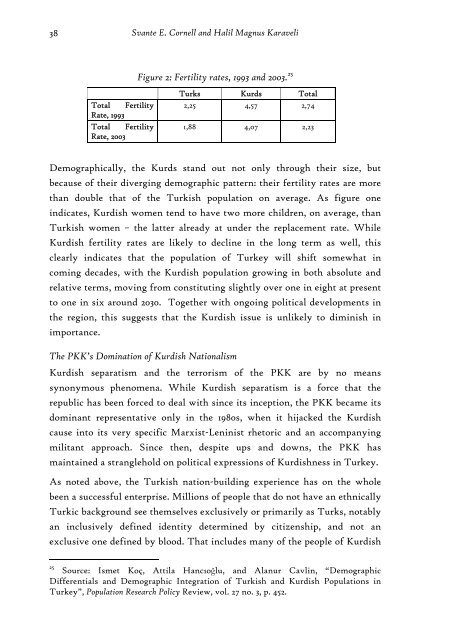2008_10_SRP_CornellKaraveli_Turkey
2008_10_SRP_CornellKaraveli_Turkey
2008_10_SRP_CornellKaraveli_Turkey
Create successful ePaper yourself
Turn your PDF publications into a flip-book with our unique Google optimized e-Paper software.
38<br />
Svante E. Cornell and Halil Magnus Karaveli<br />
Figure 2: Fertility rates, 1993 and 2003. 25<br />
Turks Kurds Total<br />
Total Fertility 2,25 4,57 2,74<br />
Rate, 1993<br />
Total Fertility 1,88 4,07 2,23<br />
Rate, 2003<br />
Demographically, the Kurds stand out not only through their size, but<br />
because of their diverging demographic pattern: their fertility rates are more<br />
than double that of the Turkish population on average. As figure one<br />
indicates, Kurdish women tend to have two more children, on average, than<br />
Turkish women – the latter already at under the replacement rate. While<br />
Kurdish fertility rates are likely to decline in the long term as well, this<br />
clearly indicates that the population of <strong>Turkey</strong> will shift somewhat in<br />
coming decades, with the Kurdish population growing in both absolute and<br />
relative terms, moving from constituting slightly over one in eight at present<br />
to one in six around 2030. Together with ongoing political developments in<br />
the region, this suggests that the Kurdish issue is unlikely to diminish in<br />
importance.<br />
The PKK’s Domination of Kurdish Nationalism<br />
Kurdish separatism and the terrorism of the PKK are by no means<br />
synonymous phenomena. While Kurdish separatism is a force that the<br />
republic has been forced to deal with since its inception, the PKK became its<br />
dominant representative only in the 1980s, when it hijacked the Kurdish<br />
cause into its very specific Marxist-Leninist rhetoric and an accompanying<br />
militant approach. Since then, despite ups and downs, the PKK has<br />
maintained a stranglehold on political expressions of Kurdishness in <strong>Turkey</strong>.<br />
As noted above, the Turkish nation-building experience has on the whole<br />
been a successful enterprise. Millions of people that do not have an ethnically<br />
Turkic background see themselves exclusively or primarily as Turks, notably<br />
an inclusively defined identity determined by citizenship, and not an<br />
exclusive one defined by blood. That includes many of the people of Kurdish<br />
25<br />
Source: Ismet Koç, Attila Hancıoğlu, and Alanur Cavlin, “Demographic<br />
Differentials and Demographic Integration of Turkish and Kurdish Populations in<br />
<strong>Turkey</strong>”, Population Research Policy Review, vol. 27 no. 3, p. 452.


